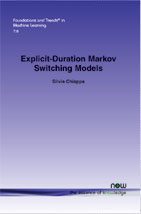Explicit-Duration Markov Switching Models
By Silvia Chiappa, University of Cambridge and Microsoft Research Cambridge, UK, chiappa.silvia@gmail.com
Abstract
Markov switching models (MSMs) are probabilistic models that employ multiple sets of parameters to describe different dynamic regimes that a time series may exhibit at different periods of time. The switching mechanism between regimes is controlled by unobserved random variables that form a first-order Markov chain. Explicit-duration MSMs contain additional variables that explicitly model the distribution of time spent in each regime. This allows to define duration distributions of any form, but also to impose complex dependence between the observations and to reset the dynamics to initial conditions. Models that focus on the first two properties are most commonly known as hidden semi-Markov models or segment models, whilst models that focus on the third property are most commonly known as changepoint models or reset models. In this monograph, we provide a description of explicit-duration modelling by categorizing the different approaches into three groups, which differ in encoding in the explicit-duration variables different information about regime change/reset boundaries. The approaches are described using the formalism of graphical models, which allows to graphically represent and assess statistical dependence and therefore to easily describe the structure of complex models and derive inference routines. The presentation is intended to be pedagogical, focusing on providing a characterization of the three groups in terms of model structure constraints and inference properties. The monograph is supplemented with a software package that contains most of the models and examples described. The material presented should be useful to both researchers wishing to learn about these models and researchers wishing to develop them further.
The supplementary data for this issue will be available soon.
Explicit-Duration Markov Switching Models
Explicit-Duration Markov Switching Models provides a simple and clear description of explicit-duration modeling by categorizing the different approaches into three main groups, which differ in encoding in the explicit-duration variables different information about regime switching/reset boundaries. The approaches are described using the formalism of graphical models, which enables graphical representation and assessment of statistical dependence, and therefore makes it easy to describe the structure of complex models and derive inference routines. The presentation is pedagogical, focusing on making distinctions that help structure the space of models and in laying out inference and learning in a clear way.
Explicit-Duration Markov Switching Models is an ideal reference for students and researchers who wish to learn about these models and those looking to develop them further.
